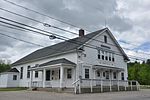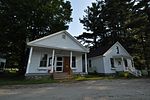Wellington State Park

Wellington State Park is a 220-acre (89 ha) public recreation area located on the southwest shore of Newfound Lake in Bristol, New Hampshire. The state park features the largest freshwater swimming beach in the New Hampshire state park system. Activities include swimming, fishing, non-motorized boating, hiking and picnicking. A 7-mile (11 km) trail system that begins in the park leads hikers to the top of Little and Big Sugarloaf mountains.The park owes its existence to the largesse of Elizabeth R. Wellington, who in 1931 turned over a tract of land known as the Wellington Reservation to the state for the handsome sum of $1. The Civilian Conservation Corps developed the park during the 1930s.
Excerpt from the Wikipedia article Wellington State Park (License: CC BY-SA 3.0, Authors, Images).Wellington State Park
West Shore Road,
Geographical coordinates (GPS) Address Nearby Places Show on map
Geographical coordinates (GPS)
| Latitude | Longitude |
|---|---|
| N 43.6436843 ° | E -71.7767465 ° |
Address
West Shore Road
03222
New Hampshire, United States
Open on Google Maps










